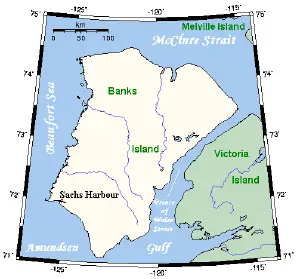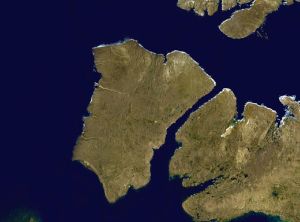Banks Island
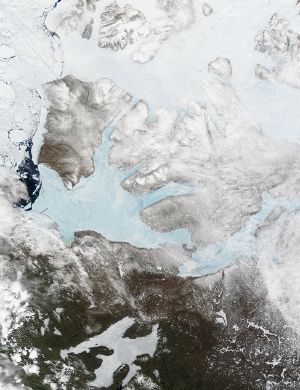 These Moderate resolution Imaging Spectroradiometer Images from June 14 and 16, 2002, show Banks Island (upper left) and Victoria Island (to the southeast) | |
| Geography | |
|---|---|
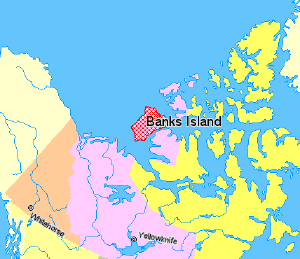 | |
| Location | Beaufort Sea |
| Coordinates | |
| Archipelago | Canadian Arctic Archipelago |
| Area | 70,028 km² (27,038 sq mi) (24th) |
| Length | 380 km (240 mi) |
| Width | 290 km (180 mi) |
| Highest point | Durham Heights (730 m (2,400 ft)) |
| Country | |
| Territory | |
| Demographics | |
| Population | 114 (as of 2001) |
| Density | .0016 people/km2 |
One of the larger members of the Canadian Arctic Archipelago, Banks Island () is situated in the Inuvik Region of the Northwest Territories, Canada. It is separated from Victoria Island to its east by the Prince of Wales Strait and from the mainland by Amundsen Gulf to its south. The Beaufort Sea lies to its west. To the northeast, McClure Strait separates the island from Prince Patrick Island and Melville Island.
It was named "Banks Island" in 1820 by Sir William Parry in honour of Sir Joseph Banks. However, during the exploration of the area by Robert McClure (1850-1854) the island was marked on their maps as "Baring Island"[1].
The only permanent Inuvialuit settlement on the island, Sachs Harbour, or Ikhuak, lies on the southwest coast. Two federal Migratory Bird Sanctuaries were founded on the island in 1961. The island is treeless, with the tallest plant, the arctic willow, growing occasionally to about the height of a person's knee but usually standing no taller than 10 cm.
Geography
The Canadian Arctic Archipelago, also known as just the Arctic Archipelago, is an archipelago north of the Canadian mainland in the Arctic. Situated in the northern extremity of North America and covering about 1,424,500 km² (550,003 sq mi), this group of 36,563 islands comprises much of the territory of Northern Canada – most of Nunavut and part of Northwest Territories.
The archipelago extends some 2,400 km (1,491 mi) longitudinally and 1,900 km (1,180.6 mi) from the mainland to Cape Columbia, the northernmost point on Ellesmere Island. It is bounded on the west by the Beaufort Sea; on the northwest by the Arctic Ocean; on the east by Greenland, Baffin Bay and Davis Strait; and on the south by Hudson Bay and the Canadian mainland. The various islands are separated from each other and the continental mainland by a series of waterways collectively known as the Northwestern Passages. Two large peninsulas, Boothia and Melville, extend northward from the mainland.
The archipelago contains 94 major islands (greater than 130 km² (50 sq mi)), including three of the world's ten largest islands, and 36,469 minor islands. The sizeable islands of the archipelago (over 10,000 km² (3,861 sq mi), in order of descending size) are:
Banks Island covers an area 70,028 km²
(27,038 sq mi) and it is the world's 24th largest island and Canada's fifth largest island. It is approximately 380 km (236 mi) long, and at its widest point at the northern end, 290 km (180 mi) across. The highest point of the island is in the south, Durham Heights, rising to about 730 m.[2] It is part of the Canadian Arctic Archipelago, and had a population of 114 in 2001, all in Sachs Harbour. Banks Island is home to two thirds of the world's population of lesser snow geese, which make their way across the Amundsen Gulf from the mainland. There is an annual goose hunt in the spring out of Sachs Harbour. The island is part of the Tundra world biome, which has extremely cold winters. The island is home to Barren-ground Caribou, polar bears, musk-oxen, and birds such as robins and swallows.
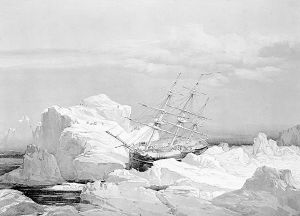
The Aulavik National Park of Canada, a fly-in park, protects approximately 12,274 km² (4,739 sq mi) of Arctic lowlands at the northern end of the island. The park has the highest concentration of musk-oxen on earth, and is home to the endangered Peary Caribou. The Thomsen River runs through the park, and is the northernmost navigable river (by canoe) in North America. Ptarmigan and ravens are considered the only year-round birds in the park, although 43 different species make seasonal use of the area.
The first Grizzly-polar bear hybrid found in the wild, was on Banks Island in April 2006 near Sachs Harbour.
Aulavik National Park
Aulavik National Park (Inuvialuktun: place where people travel) is a national park located on Banks Island in the Northwest Territories of Canada.[1] It is known for its access to the Thomsen River, one of the most northerly navigable rivers in North America.[1] The park is a fly-in park, and protects approximately 12,274 km (7,626.71 mi) of Arctic Lowlands at the northern end of the island.[1][2] The most practical way to visit the park is to charter a plane,[2] and currently the park has four landing sites.[3] Aulavik is considered a polar desert and often experiences high winds. Precipitation for the park is approximately 300 mm (12 in) per year.[4] In the southern regions of the park a sparsely vegetated upland plateau reaches a height of 450 m (1,500 ft) above sea level.[5]
The park has the highest concentration of muskoxen on earth, with estimates of 68,000 to 80,000 animals on the island, approximately 20% of which are thought to reside in the park.[6][1] It is also home to the endangered Peary Caribou as well as the more common Barren-ground Caribou.[1][6] Ptarmigan and ravens are considered the only year-round birds in the park, although 43 different species make seasonal use of the area.[7] The park is completely treeless,[8] and Arctic Foxes, brown and Northern Collared Lemmings, Arctic Hares and wolves roam the rugged terrain. Birds of prey in the park include Snowy Owls, rough-legged hawks, Gyrfalcons, and Peregrine Falcons, who feed on the lemmings.[6][7]
Prior to the arrival of the Thule culture in southern Banks Island there were some Pre-Dorset culture people living in what is now the Aulavik National Park.[9] Due to the cooling climate brought on by the Little Ice Age Banks Island was most likely deserted until the arrival of the Inuvialuit in the 17th century.[9]
Aulavik National Park has two major bays, Castel Bay and Mercy Bay, and lies south of the McClure Strait. Captain Robert McClure, spent two winters in Mercy Bay on HMS Investigator, while searching for the missing John Franklin's lost expedition between 1850 and 1853. McClure's team abandoned their ship in Mercy Bay and hiked across the sea-ice of the strait to board another ship, HMS Resolute.[9]
The Mercy Bay area was visited by the Copper Inuit of Victoria Island to salvage materials left by McClure's party.[9] They also hunted the caribou and muskox in the area as evidenced by the large number of food caches.[9] In the 20th century the area was popular with Inuvialuit due to the large numbers of foxes.[9] Until the fur trade went into decline, fox trapping provided a source of income for people from as far away as the Mackenzie Delta and the North Slope of Alaska.[9] This influx of people led to the establishment of Sachs Harbour, the only community on the island.[9]
History
http://www.pc.gc.ca/pn-np/nt/aulavik/natcul/natcul2_E.asp
Notes
- ↑ 1.0 1.1 1.2 1.3 1.4 Aulavik National Park of Canada
- ↑ 2.0 2.1 How to Get There - Aircraft access
- ↑ How to Get There - Map of Aulavik
- ↑ Natural Wonders & Cultural Treasures - Climate
- ↑ Natural Wonders & Cultural Treasures - Geography
- ↑ 6.0 6.1 6.2 Natural Wonders & Cultural Treasures - Animals
- ↑ 7.0 7.1 Natural Wonders & Cultural Treasures - Birds
- ↑ Natural Wonders & Cultural Treasures - Vegetation
- ↑ 9.0 9.1 9.2 9.3 9.4 9.5 9.6 9.7 History and culture
ReferencesISBN links support NWE through referral fees
- Canada. Banks Island, a Natural Area of Canadian Significance. Natural area of Canadian significance. Ottawa: Parks Canada, 1978.
- Cotter, R. C., and J. E. Hines. 2001. "Breeding Biology of Brant on Banks Island, Northwest Territories, Canada". Arctic. 54: 357-366.
- Gajewski, K, R Mott, J Ritchie, and K Hadden. 2000. "Holocene Vegetation History of Banks Island, Northwest Territories, Canada". Canadian Journal of Botany. 78: 430-436.
- Holyoak, D. T. Notes on the Birds of Southwestern Banks Island, Northwest Territories, Canada. Bulletin of the British Ornithologists' Club, Vol.103,No.2, June. 1983.
- Manning, T. H., E. O. Höhn, and A. H. Macpherson. The Birds of Banks Island. 1956.
- Stephens, L. E., L. W. Sobczak, and E. S. Wainwright. Gravity Measurements on Banks Island, N.W.T. Gravity map series, no. 150. Ottawa: Dept. of Energy, Mines and Resources, Earth Physics Branch, 1972.
- Struzik, Ed. 2000. "AND THEN THERE WERE 84,000 - The Return of Musk-Oxen to Canada's Banks Island in Recent Decades Is Just One Chapter of a Beguiling Arctic Mystery". International Wildlife. 30, no. 1: 28.
- Will, Richard T. Utilization of Banks Island Muskoxen by Nineteenth Century Copper Inuit. [S.l.]: Boreal Institute for Northern Studies, 1983.
- Toronto Public Library. Frozen Ocean, Search for the Northwest Passage Retrieved February 14, 2009.
External links & References
- US Coast Guard. Historical sites of the Northwest Passage Retrieved February 14, 2009.
Credits
New World Encyclopedia writers and editors rewrote and completed the Wikipedia article in accordance with New World Encyclopedia standards. This article abides by terms of the Creative Commons CC-by-sa 3.0 License (CC-by-sa), which may be used and disseminated with proper attribution. Credit is due under the terms of this license that can reference both the New World Encyclopedia contributors and the selfless volunteer contributors of the Wikimedia Foundation. To cite this article click here for a list of acceptable citing formats.The history of earlier contributions by wikipedians is accessible to researchers here:
The history of this article since it was imported to New World Encyclopedia:
Note: Some restrictions may apply to use of individual images which are separately licensed.
